 Image search results - "view" Image search results - "view" |

Practice horse track at JRA Ritto Training Center in Ritto.
|
|

View of Ryuo-cho town from Mt. Yukinoyama.
|
|

View of central Ryuo-cho town from Mt. Yukinoyama.
|
|

View of Ritto from Mt. Anyoji.
|
|

View from Mt. Anyoji in Ritto.
|
|

View of Lake Biwa from Nishinomaru on Mt. Hachimanyama in Omi-Hachiman.
|
|

Nishi-no-ko Lake as seen from Kitanomaru atop Mt. Hachiman-yama.
|
|

View of Omi-Hachiman city center from Mt. Hachiman-yama.
|
|

View of Mt. Mikami-yama amid rice paddies in Yasu. Elevation 432 meters.
|
|

Great view, but hazy when I was there. Ishibe is toward the left, and the shinkansen tracks toward the right.
|
|

Sign pointing to a lookout point, slightly below the shrine.
|
|

Going down to the lookout point.
|
|

Lookout point on Mt. Mikami in Yasu.
|
|

View from Mt. Mikami, Yasu. Ishibe is toward the left.
|
|
|

Looking toward Ritto
|
|

View from Mt. Mikami, Yasu.
|
|

On the right, Route 8 can be seen crossing Yasu River.
|
|

Route 8 crossing Yasu River
|
|

Nagahama Castle tower, local history museum.
|
|

A local non-proft group called Harie Shozu-no-Sato Committee conducts tours of Harie. For 1,000 yen, they will spend 90 min. to take you to see numerous kabata in private homes. Call 0740-25-6566 to make reservations. hariekabata.comOr email: shozunosato@lapis.plala.or.jp
|
|

Most kabata have two water sinks (ike), the one on the right (tsubo-ike) is for washing summer vegetables like tomatoes, eggplants, and cucumber. The one on the left (hata-ike) is for washing dirty root vegetables like daikon, carrots, and spinach. 川端
|
|

Imagine having a spring in your own home spewing drinkable water 24/7 for free. This kabata has a few baskets. The oblong one is used for fish, and the ones on the right were used to dry bowls.
|
|

Nakajima is really nice. But right behind this scene is a neighborhood of summer homes. Also see my YouTube video here.
|
|

Soon after we got to Nakajima, this black kite flew above. I tracked it with my camera. 「ピーヒョロロロロ…」
|
|

It then swooped down to the water and I started clicking away whether it would catch a fish or not. I was delighted to see it catch this large fish and captured the moment.
|
|

What a catch. It was my first time to capture a shot like this. I love these graceful and elegant birds which have a distinct cry.
|
|

Here's a close-up of the bird's claws grasping the gills of the fish. The bird sure knows where to grab a fish. The fish had no way to escape this grip.
|
|

Hyozu Taisha Shrine's Japanese garden at night in fall. It's really beautiful. Like someone painted colorful autumn leaves on a black canvas.
|
|

Camellias and Mt. Ibuki, Maibara, Shiga Prefecture.
|
|

Snowcapped Mt. Ibuki and Mishima Pond in winter in Maibara.
|
|

Mishima Pond with Mt. Ibuki and cherry blossoms.
|
|
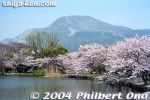
Mishima Pond with Mt. Ibuki and cherry blossoms.
|
|

Notogawa giant water wheel in Higashi-Omi, Shiga. Map
|
|

Symbol of Notogawa
|
|

The famous Karasaki pine tree as seen from Lake Biwa.
|
|

Karasaki Shrine has numerous pine trees, including the famous century-old pine tree.
|
|

Omi Hakkei (Eight Views of Omi) marker at Karasaki. Omi was the old name for Shiga. A woodblock print artist depicted the Eight Views of Omi. One of them was titled, "Night Rain at Karasaki" showing the big pine in the rain at night.
|
|

Karasaki Pine Tree is the third generation tree since the original one was planted 1,400 years ago. Current pine tree was planted in 1887.
|
|

Mt. Mikami across Lake Biwa from Karasaki.
|
|

Mt. Mikami + Pine Tree at Karasaki.
|
|

Mt. Ibuki summit area with pretty patches of summer flowers.
|
|

But the scenery is great atop Mt. Ibuki in summer. 東遊歩道
|
|

Flying over Shiraho, Ishigaki.
|
|

Coral reef along Ishigaki.
|
|

Looking at the Nosoko area of Ishigaki. Mt. Nosokodake can be seen. Bye-bye Ishigaki...
|
|

Aerial view of Nosoko, Ishigaki.
|
|

Aerial view of Ibaruma Coast, Ishigaki.
|
|

Aerial view of Ibaruma and Hirakubo, Ishigaki.
|
|

Taking off at the old Ishigaki Airport.
|
|
|

The center of this photo shows the site where the new airport was going to be built.
|
|

Shiraho
|
|
|

Shiraho coral reefs on Ishigaki.
|
|

Shiraho coral reefs on Ishigaki.
|
|

Shiraho coral reefs on Ishigaki.
|
|

Chair lift and cable car station for Amanohashidate Viewland. Short walk from Amanohashidate Station.
|
|

Chair lift and monorail car for Amanohashidate Viewland. Taking the chair lift is faster than the monorail car.
|
|

Amanohashidate from Amanohashidate Viewland (southern end).
|
|

Amanohashidate as seen from the southern end atop Amanohashidate Viewland.
|
|

Chionji Temple
|
|
|

On the lower right of the sandbar, notice the finger of sand extending into the ocean. This finger keeps growing as the northern sand erodes and drifts over to it. So every few years, they have to remove the excess sand. (Notice the power shovel and dump truck working on it.) Otherwise, this little sand spit will become another sandbar across the ocean, impeding local shipping.
|
|

Platforms where you supposed to view the sandbar upside down.
|
|

Platform to view the sandbar upside down.
|
|

On the southern end here, Amanohashidate upside down looks like a flying dragon (hiryu 飛竜).
|
|

On the southern end here, Amanohashidate upside down looks like a flying dragon (hiryu 飛竜).
|
|

That's the dragon's head in the front and the slim tail in the back. When you see it upside down, the sandbar/dragon is in the sky right?
|
|
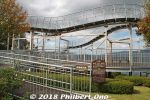
Amanohashidate Viewland has this elevated walkway to view Amanohashidate. Not good if you're afraid of heights.
|
|
|

This small ferris wheel at Amanohashidate Viewland is visible to the naked eye from across the sandbar.
|
|

Besides having lookout decks, Amanohashidate Viewland is a small amusement park for kids.
|
|

Amanohashidate Viewland's amusement park for kids.
|
|

Map of Amanohashidate Viewland amusement park.
|
|
|

Another Circle of Wisdom at Amanohashidate Viewland.
|
|

About the Circle of Wisdom.
|
|

Chairlift down.
|
|

Chiarlift down from Amanohashidate Viewland.
|
|

Built in 1894 (Meiji 27), the Jizo statue is Japan's largest Jizo statue. 地蔵大銅像
|
|

Base of giant Jizo statue covered with frogs which help people receive divine blessings from the Jizo. 身代わり蛙
|
|

Kaizu-Osaki and Chikubushima.
|
|

Moon-viewing stage 勧月舞台 and cherry blossoms at Miidera with Lake Biwa in the background.
|
|

Huge lotus pond at Karasuma Peninsula in Kusatsu, Shiga. Used to bloom in summer.
|
|

Lotus pond at Karasuma Peninsula.
|
|

Mt. Mikami in background of lotus pond in Kusatsu.
|
|

Lotus at Karasuma Peninsula in Kusatsu.
|
|

Nagisa Park in Moriyama, Shiga has this beautiful field of nano-hana rapeseed blossoms blooming in winter from early-Jan. to mid-March at this lakeside park. なぎさ公園 MAP
|
|

Yomeien Garden, Adogawa, Shiga 陽明園 MAP
|
|

The focal point of the Kurokabe Square shopping area is this "black wall" Kurokabe Glass Shop in a former bank building. MAP
|
|

Plum blossoms and Nagahama Castle.
|
|

Oil-painted card of Mt. Fuji. This is my favorite oil-painted postcard in my collection. The artist painted a few other cards like it. The artist's name was not signed, unfortunately. But the painting style is distinct.I can't define what fine art is, but I know it when I see it.
|
|

Oil-painted card of Mt. Fuji 2. Another postcard oil painting of Mt. Fuji.
|
|

"Japs" on hand-painted Mt. Fuji card. The message on this card reads: "Fujiyama, the mt. (mountain) the Japs worship. Been seeing Yokohama in a jinrichisha (rickshaw). Feb. 14."This person apparently learned a few Japanese words like "jinrikisha" which means "human-powered vehicle" that is the rickshaw. And the term "Japs" has been around well before World War II.
|
|

Painting by high school girl? This is my only oil-painted card that has a message and postmark (1910 from Nagasaki). It was addressed to a lady in Alameda, California and says in English that the card was hand painted by a Japanese high school girl.Whether this is true or not, I don't know. But the painting style of this card and the others you see here are the same. (I bought them as a set.)
|
|
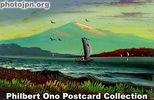
Oil-painted card of ocean and mountain. Apparently by the same artist as the preceding card.
|
|

Oil-painted card of river. Apparently by the same artist as the preceding card.
|
|
|
|
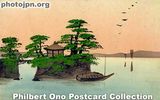
Oil-painted card of Matsushima. Matsushima is a picturesque group of pine tree islands near Sendai, Miyagi Pref. The island pictured is one of the main islands and a major tourist stop.Along with Amanohashidate in Kyoto and Miyajima in Hiroshima, Matsushima is known as one of the three most famous views of Japan (Nihon Sankei).
|
|

Kameido Tenmangu Shrine, Tokyo. Famous since the Edo Period for wisterias, this shrine has been a popular subject for woodblock artists and early photographers. The wisterias bloom around late April. The shrine is near Kameido Station on the Sobu Line.The shrine is near Kameido Station on the Sobu Line in Tokyo. Hand-colored.
|
|
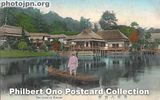
Tea house garden in Hikone, Shiga. This cozy Japanese garden has tea houses. It is directly behind Hikone Castle in Shiga Prefecture. Hikone Castle was the home of Naosuke Ii, the high official who met Commodore Perry.Today, this garden still looks pretty much the same. It was even used for a garden scene in the TV mini-series "Shogun." See photos here.
|
|
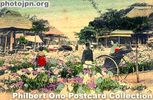
Iris Garden at Horikiri, Tokyo. This card is made of balsa wood. It shows a woman arriving at the garden in a rickshaw. I've seen this photo printed on paper postcards as well. The garden still exists in Tokyo and it's still famous for irises.See photos of the garden today. It's still famous for irises that bloom in June. Hand-colored postcard.
|
|

Lake Yogo as seen from Mt. Shizugatake in Nagahama, Shiga. This is in May.
|
|

Lake Yogo as seen from the hiking trail on Mt. Shizugatake in Nagahama, Shiga Prefecture.
|
|
|
|
|
|